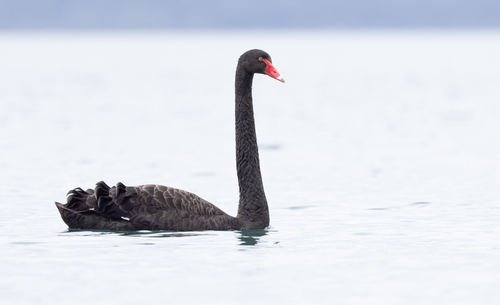
Black Swan
The Black Swan (*Cygnus atratus*) is a large waterbird native to Australia, known for its striking black plumage and bright red bill. Unlike the Northern Hemisphere's white swans, Black Swans are almost entirely black, creating a unique visual contrast. They play a significant role in Australian ecosystems, primarily as herbivores that influence aquatic vegetation. Culturally, the Black Swan has become an emblem of Western Australia and features in Aboriginal mythology. The term "black swan event" in social science derives from the unexpected discovery of this species, challenging prior assumptions.
110-142 cm
Length
160-200 cm
Wingspan
Least Concern
Conservation Status
Distribution
Primarily found in Australia, particularly the southeast and southwest regions. Introduced populations exist in New Zealand and several other countries, including the UK and the US. They are generally non-migratory but can undertake nomadic movements in response to rainfall and food availability.
Lifespan
In the wild, Black Swans can live up to 10-15 years, possibly longer. In captivity, they may live considerably longer, with some records exceeding 20 years.
Black Swan's Habitat
Habitat Types
Freshwater lakes, Brackish wetlands, Coastal lagoons, Estuaries, Rivers
Climate Zones
Temperate, Subtropical, Mediterranean
Adaptations
Black Swans are well-adapted to aquatic life. Their webbed feet provide efficient propulsion in water, and their long necks allow them to reach submerged vegetation. They can tolerate a range of salinities, enabling them to inhabit both freshwater and brackish environments.
Variations
No distinct subspecies are currently recognized. While some regional variations in size and plumage may exist, these differences are not significant enough to warrant subspecies classification.
Appearance
Breeding Plumage
Adult plumage is predominantly black, with white flight feathers visible in flight. There is no significant difference between breeding and non-breeding plumage.
Seasonal Feather Changes
No major seasonal variations occur in adult plumage. Juveniles (cygnets) are greyish-brown with black flight feathers.
Sex Based Plumage Differences
There is minimal sexual dimorphism in plumage. Males and females have similar coloration.
Notable Features
Bright red bill with a white band near the tip, Black plumage contrasting with white flight feathers, Long, S-shaped neck, Red eyes
Diet and Feeding
Primary Foods
Aquatic plants, Algae, Submerged vegetation, Grasses, Some terrestrial vegetation near water
Foraging Behavior
Black Swans primarily feed by dabbling, upending, or grazing. They use their long necks to reach underwater plants and can also graze on grasses and other vegetation near the water's edge. They may occasionally consume small invertebrates, but these are not a major part of their diet.
Specializations
Their long necks and serrated bills are adaptations for efficient feeding on aquatic vegetation. The serrations help them grasp and tear plant material.
Seasonal Diet Variations
Diet may vary slightly depending on the availability of food resources. During periods of drought or when preferred aquatic plants are scarce, they may rely more on terrestrial grazing.
Behavior
Social Structure
Black Swans are often found in pairs or small family groups, but they can also form large flocks, especially outside the breeding season. These flocks can number in the hundreds or even thousands of individuals.
Communication
Trumpeting calls, Hissing sounds (when threatened), Head-bobbing and wing-flapping displays, Soft crooning sounds between parents and cygnets
Migration
While not strictly migratory, Black Swans are nomadic and will move in response to changing water conditions and food availability. These movements can cover considerable distances.
Territorial or Group Behaviors
During the breeding season, pairs are territorial and will defend their nesting site from intruders. Outside the breeding season, they are more gregarious and often form large flocks.
Conservation
Threats
Habitat loss and degradation (due to drainage, pollution, and development), Disturbance from human activities (boating, recreation), Climate change (altered rainfall patterns affecting water levels), Hunting (though now largely illegal in many areas), Lead poisoning from ingestion of lead shot
Protection Programs
Protected under various state and national laws in Australia, Habitat restoration and management projects in some areas, Monitoring of populations, Public awareness campaigns
Local National Laws
Protected under the National Parks and Wildlife Act 1974 in New South Wales, Australia, and similar legislation in other Australian states.
Population Trend
Stable
Population Estimates
The global population is estimated to be between 300,000 and 500,000 individuals.
Interesting Facts
Black Swans were unknown to Europeans until the late 17th century.
Their discovery in Western Australia challenged the long-held belief that all swans were white.
Black Swans sometimes form same-sex pair bonds.
These pairings can be long-lasting and may even involve raising cygnets together.
Cygnets (young swans) are greyish-brown, not black.
This coloration provides camouflage and protection from predators.
Black Swans can fly at speeds of up to 80 km/h (50 mph).
Although they are large birds, they are strong fliers and can travel long distances.
Black Swans are the official bird emblem of Western Australia.
It features prominently on the state flag and coat of arms.
Faqs about Black Swan
Are Black Swans aggressive?
Black Swans can be aggressive, especially during the breeding season when defending their nests and young. It's best to observe them from a safe distance.
Can Black Swans live in saltwater?
Black Swans can tolerate brackish and saltwater environments, but they prefer freshwater habitats.
Do Black Swans mate for life?
Black Swans often form long-term pair bonds, but 'divorce' can occur, and they may find new partners if one dies.
What is the lifespan of a Black Swan?
In the wild, Black Swans typically live for 10-15 years, but they can live longer in captivity.
What do Black Swans eat?
Black swans are mostly herbivorous, eating aquatic plants and algae.
Copyright @ Nature Style Limited. All Rights Reserved.
 English
English